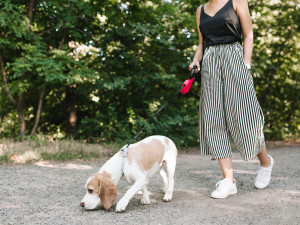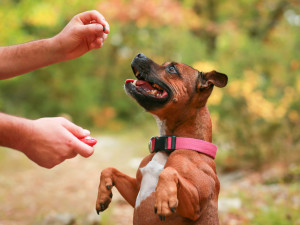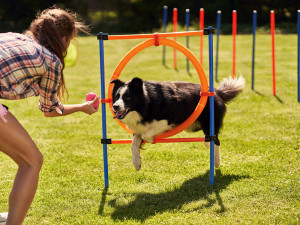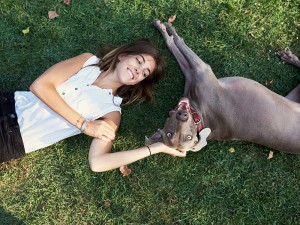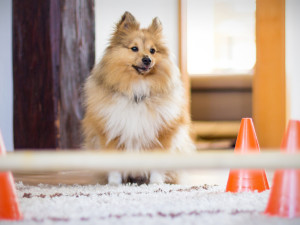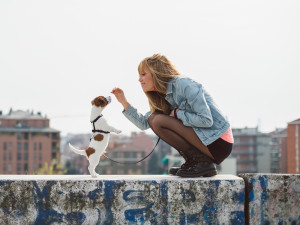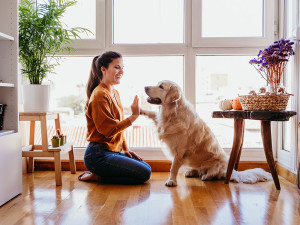Think Your Dog Can Be an Obedience Champ?
You don’t have to look like you belong on Best in Show to be a contender.
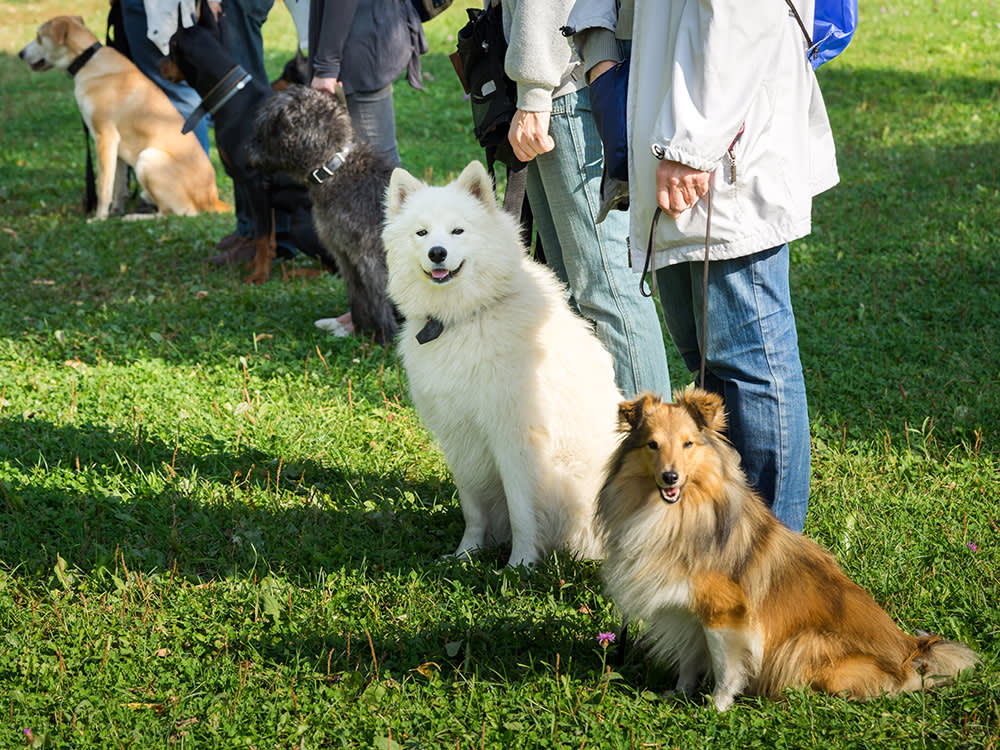
Share Article
Anyone who’s watched the 2000 cult classic Best in Show is both in awe and terrified of the dog showing world. The real-life version might not have Catherine O’Hara, Parker Posey, or Busy Beeopens in new tab (shame), but nonetheless, the hype is real.
Fans observe in awe as the dog handlers make obedience look like downright magic: With every nod of their head or sweep of their arm, the competing pup responds with an enthusiastic burst of motion or a quick halt or down. They glide together in perfect sync as the judge calls out instructions, and the small crowd gathered outside the ring quietly admires their performance. At the dramatic conclusion, the judge announces which teams qualified, and to those pairs he hands out the placement ribbons, as the audience applauds and tails wag.
On the other hand (or paw) you can barely get your pup to “sit and stay.” How do those handlers get their dogs to follow their every command? It has a lot to do with their relationship with the pup. “Obedience builds confidence in the dog,” says Kate Cowles of Iowa, who competes with four shelter dogs in UKC obedience, St. Hubert’s Companion Dog Sports Program and the Association of Pet Dog Trainers’ Rally O. “For me, the point of doing competitive obedience is to build the bond.”
At its worst, competitive obedience can look like torture for both partners. Some handlers constantly jerk at their dog’s leash or practically drag the poor thing around the ring. Other handlers become so nervous about the trial setting that they pass on that stress to their dogs, who constantly lick their lips and look for a chance to bolt.
If this is your idea of obedience, then it certainly does not conjure up images of fun with your pup. But for many people, it is a favorite pastime, and their dogs enjoy the extra attention, travel, and overall excitement. Perhaps if it were called something more flashy, like “precision teamwork” or “synchronized stepping,” more dog-lovers would pursue this challenging sport and discover its many benefits.
The Basics of Dog Obedience
At its most basic, obedience training comprises a variety of exercises that demonstrate controlled communication between handler and dog. Depending on the level, required skills can include sit, down, stand for exam, recall, heel, retrieve, jump, and scent. The degree of difficulty increases as you progress from one class to the next, known as Novice, Open and Utility in most venues.
Today, the society’s three fundamental applications can still be found at an obedience trial, no matter what the venue. Control is exhibited at all levels of obedience, especially through heeling and the dog’s response to the handler’s verbal commands or, as they progress as a team, silent hand signals. Agility is demonstrated at the Open level by asking the dog to jump over a panel jump, broad jump and bar jump. Lastly, scent work is found at the highest level, Utility, in which the dog must find an object with his handler’s scent among a pile of articles and return with the correct one.

The American Kennel Club (AKC) is perhaps the largest and most well-known venue for obedience and allows purebred and mixed breeds opens in new tab to participate in its programs. All dogs, including mixed breeds, are welcome to participate in obedience programs through the American Mixed Breed Obedience Registry (AMBOR), the Australian Shepherd Club of Americaopens in new tab (ASCA), St. Hubert’s Companion Dog Sports Program opens in new tab and the United Kennel Clubopens in new tab (UKC).
Evolving Methods
At its earliest stages and well into the 1970s, dogs were taught obedience using punishment-avoidance techniques such as the “jerk and pull” method. People believed that if the dog experienced a negative consequence for not doing what was asked, that would be enough to create the preferred behavior. This worked for some dogs, though not all. Obedience training pioneer Terri Arnold of Massachusetts, who has earned multiple Obedience Trial Championships (OTCh) in AKC over more than 30 years, was one of the first to question and improve upon traditional training methods.
In the 1970s, when Arnold started training a Shetland Sheepdog, she soon realized that choke collars, harsh commands, and withholding praise or play would not work. But, she discovered, food was an excellent motivator, and she asked her trainer if she could bring some to class. He told her she couldn’t. Her Sheltie performed wonderfully and happily at home with the food but was miserable without it in class.
“I decided to sneak food into class, and it fell on the floor from her mouth,” says Arnold. “The instructor started screaming at me in front of the class, and I said, ‘I don’t need this anymore.’ I turned around and walked away. I knew there had to be a better way. I will never forget that day as long as I live. It was a turning point in my whole life.”
The introduction of operant conditioning and clicker training to competitive obedience over the past 10 years has fostered a growing movement toward more positive and motivational instruction. In his book Clicker Training for Obedience, Morgan Spector explains how operant conditioning and the use of the clicker can shape behaviors that, together, combine into a complete obedience exercise. Dogs learn step by step instead of being expected to learn an entire skill set all at once.
The Birth of Rally-O
For someone who has never shown a dog before, the formality of competitive obedience can be intimidating. With that in mind, the AKC and the Association of Pet Dog Trainers (APDT) now offer Rally-O, a more fast-paced version of traditional obedience exercises, which takes place in a relaxed, though still competitive, setting. The judge creates a course in which the handler and dog follow numbered signs and perform the exercise described at each station. Rather than standing stiff and silent, handlers may use their upper bodies and talk to their dogs for encouragement.
“I love Rally,” says Certified Pet Dog Trainer Diane Lavigne of New York. “I think it’s a great way for a dog to get ring experience without going into the Novice [Obedience] ring. The exercises are based on what you need to do to get a Novice title.” Lavigne also competes in UKC and AMBOR obedience with her mixed-breed Hershey, AKC obedience with her Golden Retriever Skye, and is training her young Golden, Eagle, for his competition debut.
Obedience and Rally Can be Fun
If you take the time to find an instructor with whom you feel comfortable, you and your dog can grow to love obedience, rally, or both. “As long as the training is not abusive, the benefits of training are immense,” says Lori Waters, whose pack includes AKC Obedience Trial Champion German Shepherdopens in new tab, Lou, and Border Collie, Mitch, who was the first dog in AKC history to earn Conformation Champion, Obedience Trial Champion and Champion Tracker titles.
“Spending time together and learning to communicate with each other strengthens the dog-handler bond like nothing else can. After spending thousands of hours training, traveling thousands of miles showing — not to mention spending thousands of dollars — with my dogs, the way you both grow together is unbelievable. Your dog gets the attention and goes places that other dogs can only dream about. They get to live a very full life and the handler gets to share it.”
Even if you’re not interested in competition, obedience training has value. “The obedient dog benefits,” says Arnold, “because then the dog can have a good life, a chance to run free and be a dog, whether it’s in a dog park or out in the woods somewhere. It’s the most amazing thing to me, people who let dogs free that they can’t control. Love is taking the time to train the dog to keep it safe.”

Julia Lane, CPDT-KA
Julia Lane owns Spot On K9 Sports, a training facility in the Chicago area, and offers online dog-sport coaching. She is the author of several travel books, and her byline has appeared in The New York Times Magazine, Poets & Writers and elsewhere.
Related articles
![Woman laying on the grass smiling at her dog]()
10 Ways You Can Make Your Dog’s Life Better
Number 6 will probably surprise you.
![Shetland sheepdog sits in front of a obstacle course for dogs in the living room]()
3 Fun Indoor Games to Play With Your Dog This Winter
Bad weather? These activities will keep your dog (and you!) from going stir crazy.
![Young blonde woman with a Jack Russell puppy during spring in the city.]()
The Best Training Treats for Dogs in 2025
The most mouth-watering treats for training your pup.
![A woman holding a dogs paw and smiling.]()
Nine Useful Tricks to Teach Your Dog
Go beyond the basics.

